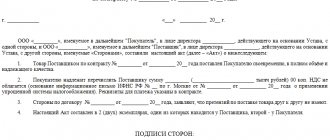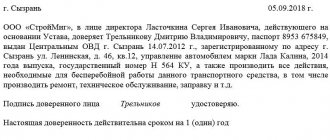Main purpose
Understanding how to create an inventory of documents allows you to establish an organization’s internal records management, which is necessary to control document flow:
- track the movement of documents between departments or outside the company and at any time determine the current location of the document you are looking for;
- optimize the work of the company and a corresponding reduction in resources, both temporary and human, which are spent on searching for the necessary data or restoring lost data.
Each company has the right to independently determine how to organize the movement of documentation, how to make transfer lists and what type they should have. There are no regulatory requirements in this part; there is a recommended form for an inventory of documents for transfer, which you can rely on when developing your own forms.
Transfer inventory, sample 2021
The form of the transfer inventory is approved by an internal act of the organization. It is desirable that it include the following sections:
- name of the organization where the documentation comes from;
- name of the organization where the package is being sent;
- date of compilation of the list;
- the serial number of each transferred unit in the package, its name, the number of sheets and copies - this information can be presented in the form of a table. It is advisable to indicate in it whether originals or copies are being transferred, and if copies, then certified or not;
- total number of sheets to be transferred;
- FULL NAME. and the position of the person transferring the package, and the signature of the recipient, as evidence that it was transferred.
The inventory is drawn up in two copies: for the transmitting and receiving parties.
If after filling out the form there are still empty lines, they should be crossed out with a pen.
Certificate of acceptance and transfer of documents: main points
Each company has the right to draw up this act at its own discretion and form.
The only important thing is that the document contains the following points:
: (click to expand)
- Name, date and place of execution of this act
- Name of the enterprise in which this transfer is carried out (for legal entities)
- Last name First name Patronymic name of the person transferring the documents (usually this is the person who draws up this document). Also, if necessary, passport information is entered.
- Last name First name Patronymic name of the person receiving the documents (if this person is an employee of another company, then the details, the name of this company).
- A list of documents transferred under this act, indicating the number of copies, number of pages, number and date of documents. If there is a large volume of material, it is quite reasonable to describe the documents in an appendix or in a special table, where each document is given its own serial number and its full characteristics. All this is necessary so that not a single document is lost.
- Signatures of the parties are placed, which means agreement with the document and the absence of claims. The seal of the company in which the documents are transferred is also affixed.
Such an act may well be drawn up between individuals without specifying organizations. There are enough details and passport data of the parties here.
It should be noted that such an act can also be used when registering a service, when the customer assumes responsibility for storing important and valuable documents for the duration of the work. For example, such a service could be the preparation of foreign travel documents. In the event of loss of original and valuable documents by the contractor, the client who has this act has good reason to contact all necessary authorities in the event of a dispute.
Another useful aspect in the transfer of valuable original documents is their copying by the transferor. The act of acceptance and transfer of documents is prepared in two copies, one for each of the parties to the transfer. Below we bring to your attention samples of such acts.
To date, the procedure for transferring cases to a new chief accountant upon dismissal of the previous chief accountant is not reflected in the current legislation. However, in order to reduce possible negative consequences, the organization must organize the transfer of affairs from the previous chief accountant to the new chief accountant. The procedure for transferring cases from the previous chief accountant to the new chief accountant occurs in several stages. When transferring cases from the previous chief accountant to the new chief accountant, the following algorithm should be followed:
Main varieties
There are several possible classifications of the lists attached to the shipment. It is recommended that organizations develop their own template for each type. Depending on what kind of transfer the list accompanies, it may include:
- to internal, if papers are transferred within a legal entity from one division to another;
- to external ones, if it accompanies a package of papers sent to another organization.
Depending on the subject of the accompanying papers:
- financial statements;
- personnel papers;
- statutory documentation.
This list of types is not closed; each aspect of the organization’s activities is accompanied by a certain document flow that needs to be organized.
Finally, a special type of list is identified - delivery notes, drawn up for transferring a case to the archive, an example of which will be considered separately.
An example of an act of acceptance and transfer of accounting documents
The act of acceptance and transfer of accounting documents when changing the director or in other cases is a document containing information about the state of the accounting records during the period of transfer of affairs to the new chief accountant. In the future, it can be used in reporting, as well as relieve responsibility from the accountant for incorrect accounting for the period preceding the change of official. The contents of the act are regulated by regulatory documents (filling template below), but can be supplemented or reduced depending on the specifics of the enterprise’s activities.
How to correctly compile a list of papers for internal transfer
The internal inventory of documents (when transferring documents between departments of the organization, this is exactly what is drawn up) should be compiled in the form of a table. The form of the table and the amount of information that must be entered into it are determined by the company’s internal administrative documents. When considering how to correctly compile an inventory of documents for transfer, you should include the following sections:
- serial number of paper;
- index - an optional element of details, placed in exceptional cases when a large volume of documentation is transferred;
- date - refers to the date of registration of the paper, that is, the day when it was accepted for accounting in office work;
- title - should briefly reflect the essence of the paper;
- sheet numbers - the sheets of the transferred package must have continuous numbering, each act occupies one or another range of pages of the case;
- note - the field is provided in case the clerk needs to make any additional notes regarding a specific sheet;
- the total number of sheets in the transferred file;
- date of compilation, position, full name. and the signature of the originator.
You can use the following form and sample document transfer inventory:
Requirements for the act of transferring documents to another person
With today's business development, quite a few questions arise regarding the financing of projects, the acquisition of equipment that require the investment of considerable funds, which is why the working capital of entrepreneurs is washed away.
One way out of the current circumstances is to rent objects. At the same time, the conclusion of a rental agreement will not be complete without drawing up the corresponding acceptance and transfer act of the object, displaying the entire list of documentation and equipment transferred to another person, in this case the tenant.
If the rental agreement reflects all the points regarding the use of equipment (terms and mode of operation, terms of payment, duration of the agreement, etc.), then the acceptance and transfer act reflects the fact of transfer of documentation, which indicates all the technical characteristics of the leased equipment, and indicates number of documents. Therefore, the acceptance and transfer act of transfer to another person plays an important role in the relationship between the parties to the transaction.
In controversial situations, a certified transfer form can be decisive, since when resolving controversial issues regarding the execution of a contract, thanks to a written act, it is possible to prove, for example, the fact of transfer of certain documentation or the commencement of the contract between the parties. We can say that the act confirms the fact that the contractual relationship has begun.
Before drawing up the acceptance and transfer form, you need to prepare the required materials that will be given to the client.
The preparation of the acceptance and transfer form begins, as noted in the previous sections, with displaying the details of the participants and marking the place and date of the certificate being drawn up. Unlike the form drawn up between institutions, the act of acceptance and transfer to another person provides for the display of information about the recipient, indicating the passport details and residential address of the individual.
The final stage in the execution of the act is its signing by the transfer and acceptance participants.
An act is a normative document drawn up in several copies and signed by the parties to confirm established events or facts. When changing the accountant at the enterprise, an act of acceptance and transfer of accounting documents is drawn up and signed. At state enterprises, this document has a unified form, but can be changed by the department due to the specifics of economic activity.
The form of completion is usually regulated by the rules on the procedure for drawing up acts, when filling out which an example is provided to avoid errors. At non-state (non-budgetary) enterprises, the act of acceptance and transfer of accounting documents can take a simple form in the form of a list of cases accepted by the new chief accountant.
Delivery list of documentation
This is a special type of accompanying documentation compiled in connection with the transfer of the case to the archive. These lists contain additional columns:
- deadline dates - you must indicate until what date the paper should be stored. The date is determined in accordance with the archival storage norm, as a rule, it is five years;
- shelf life.
We recommend making an inventory of the documents being transferred and filling it out according to the template.
The act of accepting the transfer of documents to another person
The acceptance and transfer act is an annex to the agreement between the parties and ensures the fact of transfer of goods from the contractor to the customer. The conclusion of an agreement between the contractor and the customer is carried out in accordance with the legislation of the Russian Federation. And the signed acceptance and transfer act is only an official recording document with the help of which the transfer of business documents is carried out.
This certificate of transferred documentation has legal force.
The form for drawing up a certificate of sending documentation to another person provides for the display of the following items:
- Title of the certificate.
- Date of signing.
- Place of signing.
- The name of the transmitted materials in the form of a list.
- Number of materials transferred.
- FULL NAME. participating parties.
- Basis for the form.
- Signatures of the parties.
- Stamps.
The generated certificate can also display information about the documentation. At the same time, the section with claims must be described separately.







